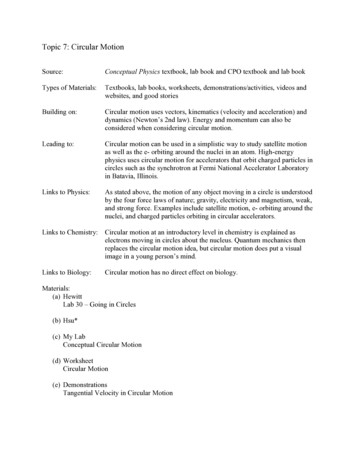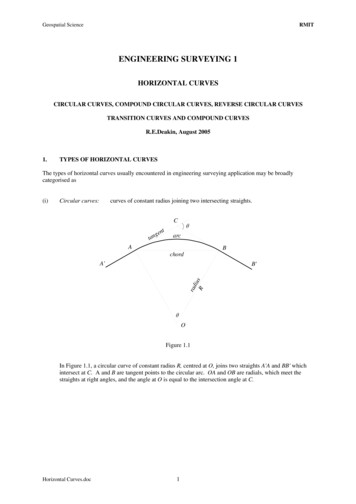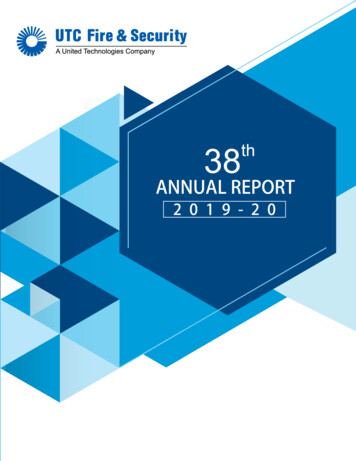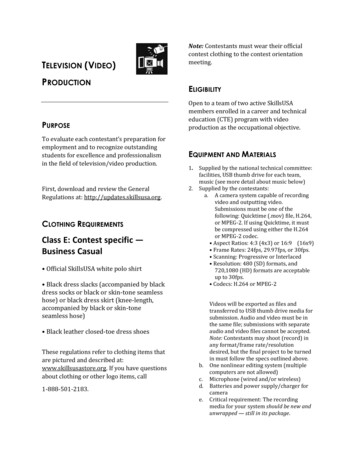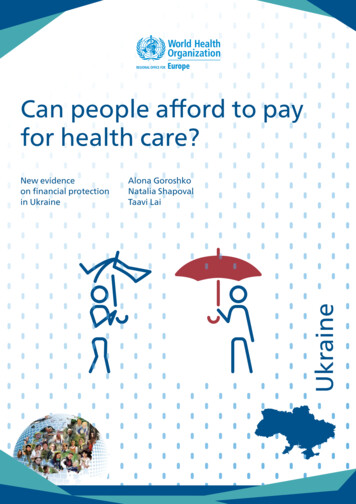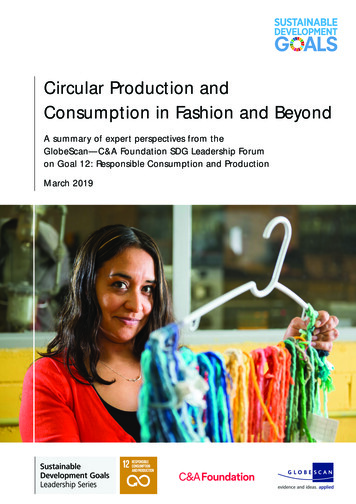
Transcription
Circular Production andConsumption in Fashion and BeyondA summary of expert perspectives from theGlobeScan—C&A Foundation SDG Leadership Forumon Goal 12: Responsible Consumption and ProductionMarch 2019
2 ContentsIntroduction from GlobeScan . . . . . . . . . . . . . . . . . . . . . . . . . . . . . . . . . . 3Introduction from C&A Foundation . . . . . . . . . . . . . . . . . . . . . . . . . . . . . . 4Executive Summary . . . . . . . . . . . . . . . . . . . . . . . . . . . . . . . . . . . . . . . . . . 5The Fashion Industry . . . . . . . . . . . . . . . . . . . . . . . . . . . . . . . . . . . . . . . . 6Circular Economy Business Models in Practice . . . . . . . . . . . . . . . . . . . . . . 8Barriers and Solutions . . . . . . . . . . . . . . . . . . . . . . . . . . . . . . . . . . . . . . . 12Crucial Actors for Unlocking Circular Models . . . . . . . . . . . . . . . . . . . . . . 18Ways Forward . . . . . . . . . . . . . . . . . . . . . . . . . . . . . . . . . . . . . . . . . . . . . 21Additional Examples of Sharing Services. . . . . . . . . . . . . . . . . . . . . . . . . 23List of Expert Guest Contributors . . . . . . . . . . . . . . . . . . . . . . . . . . . . . . 25
3 IntroductionsIntroduction from GlobeScanThe Sustainable Development Goals (SDGs) provide a roadmap for the future we all want.However, while the initial launch of the Global Goals captured the imagination of businesses, governments, multilateral organisations, NGOs, and parts of the media, a greatdeal more engagement and awareness is required to deliver on the 2030 targets.At GlobeScan, we believe more leadership is needed to inform, inspire, and catalysecollective action across the SDGs. One way to foster more leadership is to listen to andengage stakeholders worldwide.To do this, we are hosting the SDG Leadership Series. This is a series of 17 open, onlineevents—one for each of the 17 Global Goals—to foster discussions with thousands ofinfluential stakeholders across the world.We are delighted to have co-hosted this forum with C&A Foundation on Goal 12:Responsible Consumption and Production.Decoupling economic growth from resource use is one of the most critical and complexchallenges facing humanity today. Our forum explored how the fashion industry is takingon board principles of the circular and sharing economy and what can be learned fromother industries. We identified challenges and solutions to making progress and identifiedthe key stakeholders who need to be involved and engaged.Many examples were cited during the forum, showcasing some of the progress that hasbeen made in developing a more circular industry. The challenge now is to learn from andbuild on these experiences and insights in order to bring initiatives to scale.Chris CoulterCEO, GlobeScan
4 IntroductionsIntroduction from C&A FoundationThe promise of fashion is a positive one. Every day, the industry brings jobs and powerseconomies, it encourages creativity, and gives us new ways to express who we are andhow we feel. At the same time, today’s fashion industry also has negative effects—on theenvironment and on people and communities around the world. Tackling this requires braveleadership in every corner of the industry. It requires us to think out of the box and disruptthe status quo.Sustainable Development Goal 12 on Responsible Consumption and Production challengesthe entire fashion industry to come together to think about innovative solutions. For us,this includes “circular fashion”.This means applying circular economy thinking to redesign the apparel industry to makeit work for the people and ecosystems it touches. It means challenging the industry on itsmaterial sourcing, chemical choices, manufacturing decisions, business models, and endof-use options.It means putting in place a system in which safe materials are used endlessly, water is restored and energy is clean, and people work with dignity. It allows the apparel sector to bea force for good. C&A Foundation’s aim is to foster this new system by enabling best practice today and supporting the innovation of tomorrow. But to do that we need the best andbrightest minds working together. That is why we were pleased to have co-hosted thisforum with GlobeScan on Goal 12: Responsible Consumption and Production. It gave usmuch needed insight, but more importantly, it created connections and discussions. Andultimately it is only by fuelling those connections that we are going to build a new fashionindustry.Leslie JohnstonExecutive Director, C&A Foundation
5 Executive SummaryExecutive SummarySustainable Development Goal 12 aims to “do more and better with less” by ensuring sustainable consumption and production.For our SDG Leadership Forum on Goal 12, GlobeScan and C&A Foundation were joined bymore than 250 guest contributors and participants from brands, manufacturers, funders,innovators, academics, and government who made a total of 1,361 individual contributions.Our discussion focused on the fashion industry specifically and how we can scale the adoption of circular business models and accelerate the transition to a circular economy.Overall, the forum highlighted the need for multi-stakeholder collaboration—in creating anetwork for circular businesses, developing strategies, and combining workforces for moreefficient processes. This was emphasised throughout the whole discussion, with many participants expressing the need for a sharing platform that enables progress from actors across thevalue chain.There are still many barriers to the fashion industry achieving a circular and collaborativebusiness model. These include a business culture dependent on “fast fashion” and a traditional, linear supply chain, as well as limited knowledge of circular approaches and a lack ofconsumer demand for sharing and service models.A wide range of solutions are needed to tackle these challenges. First, a strong businesscase would bring on board the wider industry and help sell the benefits of quality anddurability to consumers. Second, several factors facilitate the transformation—such asleadership, collaboration, and innovation. Third, new initiatives in subscription, service,and repair models should be developed and scaled. Fourth, there is a need for education incircular design and production, as well as consumer communication and engagement. Finally,incentives and regulatory changes have a crucial role in accelerating the shift to circularprinciples.Going forward, organisations like C&A Foundation and Fashion for Good will be crucial inraising awareness of circularity, encouraging change, and accelerating the uptake of circularand sharing models.The SDG Leadership Forum on Goal 12 demonstrates the progress that parts of the fashionindustry have made toward becoming more sustainable. Sharing and applying the lessonslearned will enable the transformation at scale.
6 The Fashion IndustryThe Fashion IndustryKey LearningOverall, the fashion industry is seen as a laggard in terms of circular models acrossthe value chain. Although examples of small circular and collaborative businessesexist, these are not at scale. To be effective, the industry should work together todevelop creative and actionable initiatives.The forum began by asking whether the fashion industry is a leader or a laggard in terms ofcircular models for product design and manufacturing processes. The majority view was thatindustry efforts have had limited impact. However, there was a sense of optimism with manyparticipants noting an increase in circular initiatives in recent years.Three elements are needed to make further progress:1. Collaborative action from key industry players can create and define a purposeand structure for circular initiatives.The industry is making slow, but strong steps toward circularity. We have bigstakeholders in this industry who are really striving and supporting this modelby looking at every aspect of the production of clothing from design to manufacturing to consumer education, and to recover all that product that we putin this world to go back into the circle. But it’s only through collaboration thatwe will achieve this change.– Carmen Gama, EILEEN FISHER2. Demonstrable proof of successful initiatives that have visibly employed the circular model will help to gain support from the industry.The fashion industry is at the beginning of its reflection on circularity butthere is great momentum and a lot of progress has been made in terms ofawareness, although this has not yet resulted in a lot of concrete results.– Charline Ducas, C&A
7 The Fashion Industry3. Creative expertise and a future-focused mindset, which are already characteristicsof the fashion industry.Unfortunately, I would say that the fashion industry has been slower thanmany other industries. We need to speed up the shift toward waste-freemodels and a circular economy. I believe this industry has a unique rolethanks to the creativity, global reach, and forward mentality. So, we shouldbe able to use this and inspire change even beyond our own industry.– Diana Amini, H&M Foundation
8 Circular Economy Business Models in PracticeCircular Economy Business Modelsin PracticeKey LearningThe most successful examples of circular and sharing economy models tend to focuson the consumer rather than on sustainability. To maximise engagement, brandsshould communicate the personal benefits of the model, with sustainability beingan added bonus.Despite a general consensus that the industry has been slow to adapt to circular businessmodels, forum participants were able to name many examples (both in and outside the fashion industry) that demonstrate the benefits of a sharing and collaborative economy. The mostpopular models mentioned in the forum were those that balance the “sustainable” value ofproducts without compromising on overall consumer benefits. Participants emphasised theneed for these models to be logical choices for consumers, combining conventional elements(e.g., quality, price, convenience) with circular principles.Generally, the best ones out there are those with an ability to addresslarger markets by offering their service or product not solely on the premiseof conscious consumption, but by making their solution easy to adopt andnear-similar in appearance or experience as conventional alternatives.– Erick Bouwer, VIGGAExamples of Collaborative and Sharing Economy ModelsEILEEN FISHER RenewTake-back, reuse, and remake scheme that committed to being circular by design.Eliot Metzger of the World Resources Institute cited EILEEN FISHER as an example of howbrands are integrating circular business models into their mainstream business strategies.EILEEN FISHER (an American clothing brand) has created “Renew,” a take-back and re-usescheme which allows people to trade their old EILEEN FISHER clothes in exchange for 5 rewardcards. Once received, the brand assesses the quality and condition of the items. Those whichcan be renewed will be, and those which cannot will be regenerated into new fibres.More information can be found here.
9 Circular Economy Business Models in PracticeLena Fashion LibraryA clothing library in Amsterdam which allows members to lend and rent clothingeach month. The aim is to “encourage consumers to consume more consciously.”Gwen Cunningham of Circle Economy shared Lena Fashion Library in Amsterdam as an example of a successful sharing economy model. Lena serves the wider community in Amsterdamthrough local swap points.The clothing library “offers consumers access over ownership to seasonal, high-quality,vintage clothing and sustainable brands.” As an accessible service, consumers can choose between monthly subscriptions or one-off rentals. Members have “points” that determine theamount of clothes they can have in their possession at once. There is no limit to the amountof times clothes can be changed (as long as it stays within the points limit), and there areswap points located throughout Amsterdam to serve the wider population.More information can be found here.VIGGAA circular subscription model for maternity and children’s wear.Holly Browne, formerly with MADE-BY, mentioned “VIGGA” as one of her favourite examples ofbrands that “tackle real-life issues for customers and truly help reduce consumption.”VIGGA is a circular clothing concept in Denmark tackling the issue of outgrown children’swear. The subscription service enables parents to lease sustainable and organic maternity andchildren’s clothing. Customers are sent 20 VIGGA garments in their size and once they nolonger fit, they return them and are sent a new package of clothes in a larger size. Returnedclothes are treated and checked, then repackaged and sent to the next customer.More information can be found here.Please see page 23, “Additional Sharing Services” for more examples.
10 Circular Economy Business Models in PracticeLessons from Other IndustriesThrough our participant poll, we asked which industry sector is currently the most advancedin creating circular product designs and/or manufacturing models. Results showed that theelectronics industry is considered a leader in circular models, with the food and beverageindustry following closely behind.POLL 1Poll sector1Which industryis today most advanced in creating circular product design and/ormanufacturing models? (n on8%8%19%Food13%17%AutomotiveC&A19 poll 1Examples provided by participants highlight the range of initiatives from different sectors,with a focus on their ability to bring circular economy business models to scale. The plasticsindustry was cited by several participants as a sector that is gradually being transformed.Peter Majernowski, of Tyton BioSciences, mentioned the “endless loop” of plastic bottles(PET) that goes into “everything from textiles to carpets and more.”Chris Coulter, of GlobeScan, referenced the carpet industry and Interface specifically, ashaving “pioneered the concept of closed loop and circularity.” Sandy Black, at the Centre forSustainable Fashion, also noted that the tech industry has been “excellent at forming interdisciplinary teams” which is now starting to happen in the textile industry for circularity usingbio waste.
11 Circular Economy Business Models in PracticeFour Main Lessons from Other Industries1. Lead the wayTaking the lead and being a forerunner for the circular evolution will set brands and retailersapart and help initiate more action.As Douwe Jan Joustra from C&A Foundation noted, “there always needs to be someone whodares to start from a new perspective.”2. Collaborate for scaleIn line with SDG 17, partnerships are critical for enabling pilot projects to be brought toscale. Diana Amini, of the H&M Foundation, emphasised the need for “collaboration acrossthought borders and sectors.” Combining the intelligence of a range of sectors will help toaccelerate the rate at which a circular fashion industry can be achieved.3. Leverage elements of successful modelsAs with the examples above, it is crucial to identify relevant case studies and apply the elementsthat contribute to the overall success of the model. Using these “tried and tested” routes is aneffective enabler of positive results and can foster collaboration with companies on a similarjourney.4. Commit to circularity in its entiretyIt is critical to demonstrate passion for the process of developing new norms. Demonstrablecommitment to adopting circular business models through lobbying, marketing, or campaignscan be the difference between a model that is successful and one that is not. As Sandy Black(Centre for Sustainable Fashion) notes, “passionate individuals make a difference and can starta movement.”
12 Barriers and SolutionsBarriers and SolutionsKey LearningParticipants identified several barriers to the adoption of circular principles. Theserange from the ubiquity of traditional systems for design and manufacturing and abusiness culture dependent on fast fashion, to limited knowledge and innovation incircular models and a lack of consumer demand. Five main solutions to addressingthese challenges emerged during the discussions: making a business case; attributesfor transformation; new subscription and service models; education and consumercommunication; and incentives and regulatory change.Barriers to adopting circular processes and collaborativeconsumption modelsBarrier #1: Traditional linear systemThe fashion industry has operated under the same linear system for decades. There are nobusiness incentives to change, and the prospect of doing so is seen as more of a risk than anopportunity. While small initiatives and start-ups are important for instigating circular concepts from the ground up, larger fashion designers and manufacturers need to demonstrateleadership in order to bring new models to scale. Setting an agenda, sourcing, and supplyingfunding for innovation will all be important areas for the industry to address.Barrier #2: Limited knowledge of circularThere is limited understanding of circular business models. The key fashion industry playerswho will need to drive the change are ill equipped to lead the evolution across a complexsupply chain. To be efficient in implementing the model, all actors involved in the fashioncreation process will require sufficient knowledge on circularity in order to properly adapt.Barrier #3: Demand for “fast fashion”“Fast Fashion” is the process of creating inexpensive clothing to meet consumer demand fortrend pieces. Consumers are reluctant to shift from the consumption of fast fashion whilethere are attractive alternatives that strike an acceptable balance between price, style, andsustainability. If consumer behaviour does not change, then fashion brands will be unwillingto commit to circular models.
13 Barriers and SolutionsBarrier #4: Consumer resistance to sharingA major challenge for fashion brands is how to sell access over ownership. Consumers arecomfortable with the idea of owning their clothing, and the concept of “sharing” gives riseto concerns associated with second-hand clothing. Social stigma, hygiene, quality, cost, anddurability are just a few of the issues associated with collaborative models.Barrier #5: Business cultureMaking the shift from the current business model of fast fashion to a more sustainablemodel will be difficult. Finding a way to address the conflicting objectives of the fast-fashionindustry (high sales targets and profits) and the circular and collaborative economy (ensuringsustainable consumption) is crucial for bringing retailers on board with new models.Solutions to ChallengesMany solutions were generated during the discussions about challenges in circular design,production, and the sharing economy. These are grouped into five main areas.1. Making a business caseThere are several ways to “sell” the circular and sharing economies to the industry and toconsumers.Tackling qualityIf consumers are expected to shift their behaviour, there must be a powerful case fordoing so. Clothes that are high quality and long lasting with the potential for repair cansupport increasing the demand for circular fashion.There’s another component of product design important in rating circularity,and that is durability. The more durable products that last as long as possible,that also are repairable, won’t have to be recycled as frequently, therebyreducing—potentially drastically reducing—the product’s footprint over itslifetime. That is apart from whether the product’s materials of constructionare closed loop or even recycled. So, at Patagonia our thinking of “circularity”includes durability and repairability in addition to recyclability. We capturedthose goals in our Worn Wear program, which is a partnership with ourcustomers to take mutual responsibility for our products around the four“Rs” of repair, reuse, recycle, and reduce.– Rick Ridgeway, Patagonia
14 Barriers and SolutionsApply consumer insightsIf sharing and collaborative models are to be successful, the fashion industry must develop strategies with real-life consumer insights in mind. GlobeScan research looksspecifically at the rise of the Aspirationals, consumers who are defined by their love ofshopping, desire for responsible consumption, and their trust in brands to act in the bestinterests of society. Research that segments consumers can help brands to devise theirmarketing and communication strategies and appeal to target groups.Michael Waas from TerraCycle Inc. emphasised market research which “shows consumersare looking for more sustainable/purpose-driven products across most product categories.”Consumer benefits firstIn selling the service model, brands should be careful when constructing their marketingstrategy. Several participants agreed that sustainability and circularity should not be thecore selling points, but rather personal benefits such as convenience, availability, quality,and accessibility of new trends.Focus on the benefits—trying clothes you wouldn’t normally buy, you canbe more adventurous without the risk. If something doesn’t fit or doesn’tlook great you can send it back and try something else. For young people,it’s a cheaper way to shop. Millennials and Gen Y are the most eco-consciousgenerations ever—but have a big value-action gap between their eco-valuesand what they buy. They don’t feel good about this—help give them a solution.– Natasha Parker, Global Action Plan2. Attributes for transformationTo transform to circular business models, the industry needs to foster several key actions:Strong LeadershipAcross companies, C-suite leadership is particularly important to gain support for circularity and the shared economy.The CEO Guide to Climate Action report by the World Business Council for SustainableDevelopment (cited by Cristina Sánchez of Fashion Revolution Spain) is a guide aimed atproviding CEOs clarity on how to engage their company on sustainability.
15 Barriers and SolutionsComprehensive approachWhen presented with the enormous task of transforming the fashion industry, companies must recognise that solutions will need to be multi-faceted.Edwin Keh (Hong Kong Research Institute of Textiles and Apparel) specifically proposedthe need for “a more comprehensive approach to the circularity challenge.” Solutionsshould address issues arising in the existing business model, technology, engineering,retail model, and suppliers. Creating a sophisticated plan that addresses each area ofthe business will facilitate a smooth transition to circular models.Collaboration and partnershipsTo realise SDG 12 through the principles of circularity, it will be crucial for industry playersto work together. Collaboration and partnerships (in line with SDG 17, Partnerships for theGoals) between the fashion industry, government, and academia will enable cross-sectorstakeholders to align their strategies.Case Study 1Jeffrey Hogue from C&A cited the Ellen MacArthur Foundation’s Make FashionCircular initiative as an example of an engagement platform making “the necessarynods to work together amongst stakeholders.” The Make Fashion Circular initiativebrings together fashion industry leaders with the aim of collaboration and innovationin the textiles industry, in line with the principles of the circular economy.InnovationEncouraging innovation, particularly among designers, textile producers, and manufacturers, is the foundation for building a circular economy. Several participants mentionedthe need to invest in innovation to help accelerate the movement. Solutions such aschemical recycling or innovative fibres, mentioned by Katrin Ley from Fashion for Good,are examples of innovations that can disrupt the industry. And critically, these innovatorsmust be linked with industry leaders to help take ideas to scale.To drive real change through disruptive innovation, collaboration is key. Onthe one hand, you have start-ups and innovators with breakthrough solutions,but they are often stuck in the labs and struggle to reach scale. On the otherhand, you have large corporations who are looking for innovations andsolutions to their supply chain challenges. Connecting these innovators withthese large, mainstream corporate players is a crucial step in driving adoption,enabling tipping points, and creating real change toward circularity.– Katrin Ley, Fashion for Good
16 Barriers and Solutions3. New subscription, repair, and service modelsNew models provide consumers with an alternative to conventional consumption, while stillproviding the “fast” element in the forum of exchange. Not only do subscription or rentalmodels keep prices low (usually set at a fixed price per month/item), they also keep clothesin circulation so as to minimise or avoid waste. These models promote access over ownershipand help to keep the cycle of reuse and re-wear in motion.Case Study 2: Rent the RunwayRachel Kibbe from Helpsy provides the example of Rent the Runway, an online servicethat provides designer dresses for rent at a fraction of the retail price. Their ethos is simple—by renting, you are saving resources that would have been used to manufacturenew clothing, you are being sustainable by being less wasteful with clothing, and youare extending the lifecycle of the product.As noted by Rick Ridgeway of Patagonia, ingraining repair, reuse, recycle, and reduceinitiatives in fashion brands is critical for driving sustainability. Providing consumers witha legitimate motive (e.g., wear our clothing and we will repair or recycle it) for investingin circular brands will help to drive demand. According to Gwen Cunningham from CircleEconomy, “connecting existing infrastructure to new developments and pilots, making useof the capacity, skills, and knowledge already in existence is key.” If fashion brands canincorporate repair models into their current business strategy, this will also help strengthenthe brand connection with existing consumers.4. Education and consumer communicationInitiatives to educate designers, merchandisers, and suppliers would help instil an understanding of circular processes and principles.Vivek Singh from Your Public Value suggested that organisations “embed the circularproduction and economy principle in their codes of conduct” to help aid compliance withthe model. At the same time, integrating sustainable values in fashion universities and highereducation curriculums will instil circular concepts in future industry leaders, thus facilitatingthe transformation process through ingrained teachings.Sandy Black, from the Centre for Sustainable Fashion (CSF) of the University of the ArtsLondon, said that education is one of the prime activities at CSF. She gives the exampleof the recent launch of the “first online sustainable fashion course in collaboration withKering.” The course provides an introduction to the issues, agendas, and contexts involvedin making the fashion industry sustainable.
17 Barriers and SolutionsMaking consumers aware of the impact of their shopping habits and educating them on thecircular economy is critical for gaining support for sharing models. Raising awareness throughdifferent platforms can help to make circular and sharing initiatives more mainstream. CarolineHolme, at GlobeScan, cited Elle UK’s sustainable fashion edition as a strong example of thepower of media. By engaging consumers through advertisements in stores, in public, and onsocial media, the message will remain consistent and clear.Trend-led consumerism must be forced to be made in a way that reduces itsimpacts and is recyclable, entirely—then it can be made into next season’strends—and if those were rented, then returned wholescale and got rid of, itwould be great.– Holly Browne, formerly MADE-BYMany participants felt that celebrities and influencers have a powerful roleto play in endorsing circular, sharing, and collaborative business models.Tapping into their potential is critical for raising awareness and appealing tomainstream consumers.– Sigrid Barnekow, Mistra Future Fashion5. Incentives and regulatory changesIncentives and regulatory changes are powerful tools for supporting and accelerating themove toward a circular economy.Arthur ten Wolde of Ecopreneur.eu suggested financial incentives in the form of “extendedproducer responsibility (EPR), tax shift, and VAT differentiation” were practical examples ofleveraging cost for overall good. Legislation is also referred to as a lever for shifting the statusquo. Chris Coulter of GlobeScan proposed learning from the “progressive regulatory schemesin Brussels and California” that have shown how regulations can help to “shift industriestoward more circular behaviours.”The “carrot and stick” approach has been utilised in reducing plastic bag use in the UK, andseveral participants mentioned it as a possible solution to disrupting the industry. Simpledeterrents for consumers of fashion can also play a role—for example, deposits for clothes(similar to those introduced for plastic bottles in the USA).Right now, there are few disincentives for linear consumption. NYC spends 60M/year carting textiles to landfills. If consumers/residents/businesses feltthat cost (like through Pay to Throw programs some municipalities have),perhaps that could help people start to treat clothing more like a commodityand less like trash.– Kate Daly, Closed Loop Partners
18 Crucial Actors for Unlocking Circular ModelsCrucial Actors for UnlockingCircular ModelsKey LearningAlthough it is essential to involve individual actors for specific elements, there isgreater opportunity in engaging with all actors and leveraging collaborative effortsto realise the full potential of circular business models.Many participants emphasised the need to bring everyone on board with the movementtoward a circular and shared economy. To achieve an industry-wide transformation, all actorsneed to be involved and co
The forum began by asking whether the fashion industry is a leader or a laggard in terms of circular models for product design and manufacturing processes. The majority view was that industry efforts have had limited impact. However, there was a sense of optimism with many participants noting an increase in circular initiatives in recent years.
